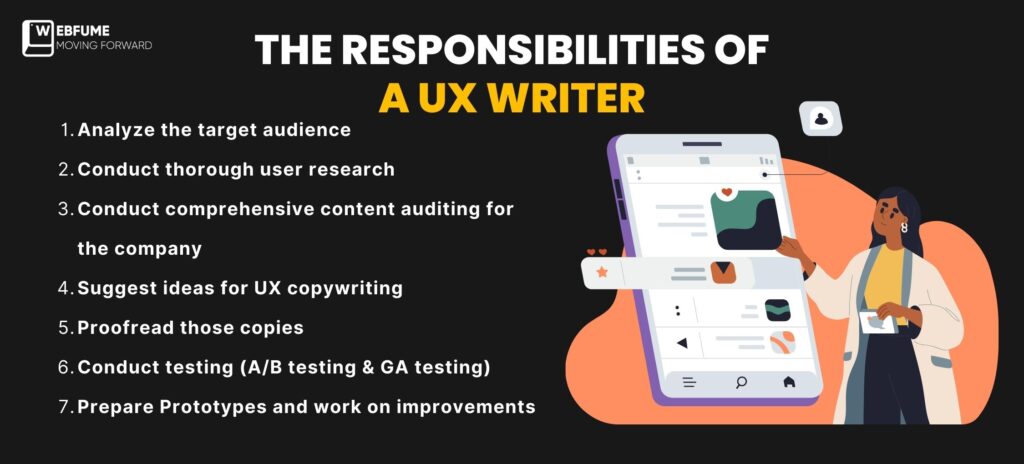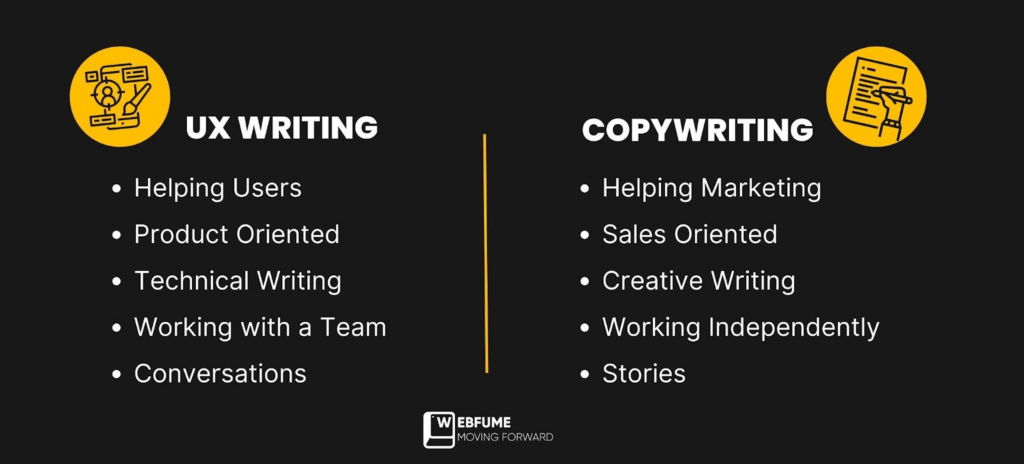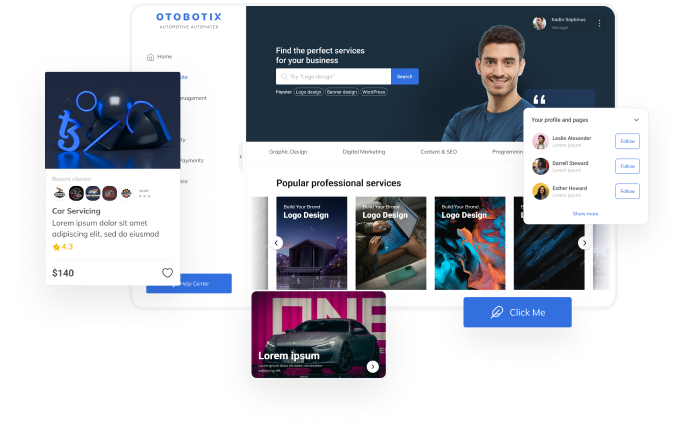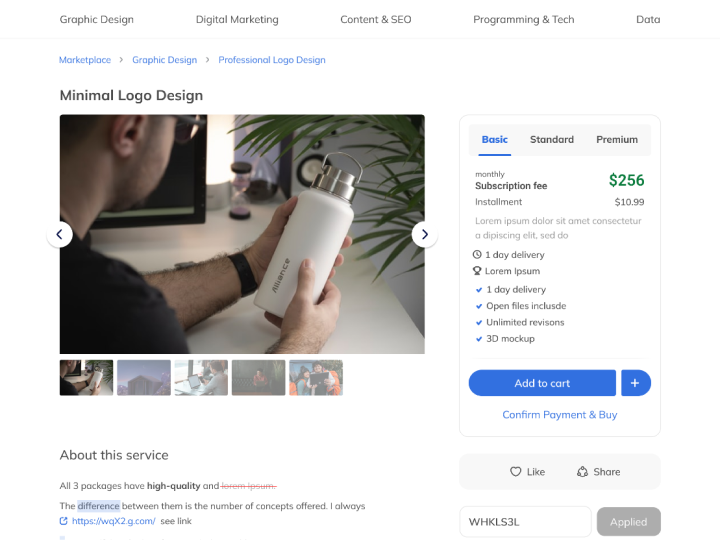If you’re searching for a comprehensive guide to UX writing, you’ve come to the right place. This blog post will cover everything about this exciting and ever-growing field.
This comprehensive guide will introduce you to UX writing basics and how to apply them to your website. With a few simple tweaks, you can create engaging and user-friendly interfaces that keep your customers returning for more! And, who knows, maybe you’ll even surprise yourself with your newfound knack for UX writing!
So no matter whether you’re a beginner or a pro, this post will surely give you the tips and tricks to uplift your UX writing game. Get ready to take your website to the next level – with the help of some expert-level UX writing!
What is UX Writing?
UX writing creates user-friendly, practical, engaging content for websites, apps, and other digital products. It’s all about understanding what users need and want and then using that knowledge to create a copy that meets their needs.

To make it more straightforward and understandable, I’d like to list down the elements of UX writing:
- Error messages
- Responsive CTAs
- Prompt messages
- Onboarding instructions
- Landing page preparation
- Content for settings and buttons
- Pop-up and push notification content
We’ll discuss each of these in detail further in the blog! So, stay tuned!
UX writing is one of product design’s most important but often overlooked aspects. The words and microcopy you use in your product can make or break the user experience.
It’s essential to take the time to get your UX writing right. The minor details can make a big difference in the overall user experience. So, to improve your product’s usability, consider the importance of good UX writing.
Research has shown that a single bad experience can drive away up to 32% of loyal customers – PWC. Don’t let that happen to your business. Make sure you take the extra time to create a top-notch user experience with the help of quality UX writing.
Before diving into the details of good UX writing, its categories, and its worth, let’s get ourselves clear on
- Who is a UX writer?
- What are the responsibilities of a UX writer?
Who is a UX Writer?
- A UX writer is a multi-talented copywriter who exhibits his writing skills via transparent and concise copywriting for products and digital experiences.
- His daily tasks involve the constant contribution of product design teams, product managers, UX- researchers, and front-end developers to ensure design synchronization with writing.
- UX- writers are also called UX- content strategists, digital copywriters, product writers, and content designers.
What is the Responsibility of A UX Writer?
As a UX- writer, one is responsible for the entire content for products and services, user navigation text, and an active contribution to the design team. UX writers must create engaging, easy-to-understand content and display it correctly across different devices. A recent survey found that an overwhelming 45% of users expect content to be displayed similarly on other devices – leadpages. This emphasizes the importance of UX writing optimized for different screen sizes and layouts.
We’ve divided this complex web into total points. Let’s have a look.

Analyze the target audience
With this step, you can write a compelling copy. Your target audience identification acts as a first step toward conversion. You should prefer creating buyer personas. Place yourself in the shoes of your target audience and ask yourself:
- What is the need for the product?
- What are the features of the product?
- How is the effect beneficial for the audience?
- What kind of audience will value the product?
Then examine your writing by analyzing the following:
- Is your content engaging and delivering the core purpose of the product?
- Is your writing keeping pace with the current trends?
By understanding the interests and preferences of the target audience, you can personalize your content to suit their needs best. According to recent research, 54% of users want to see content tailored to their interests- Adobe. With the help of content auditing tools and personalized content, you can create content that is more likely to engage users.
After you create a clear picture of your target audience, you can move to the next step.
Conduct thorough user research
Now that you know your target audience, you should know the phases a user passes through, from researching the product to buying it.
- When will the audience feel the need to use this product?
- What solutions will they be researching through these products?
- What will be the age and location of the majority of users, and how will they utilize this product
- Are the instructions provided understandable?
- Is the walkthrough optimized enough to guide the users to use this product efficiently to solve their problems?
Considering all these questions, you can create a copy to create a smooth user experience for the clients.
Studies show that users can settle on a vital area of a page in as little as 2.6 seconds- CXL. That’s why it’s essential to utilize excellent UX writing skills to show off the most critical elements of your product or service in that short period.
Conduct comprehensive content auditing for the company
Before writing the copy, look into the already registered content and edit to eliminate all the previous issues to leave an excellent first impression on the audience. Ahrefs is a great content auditing tool. It helps you quickly analyze and track the performance of your content. It also offers insights into where you can improve and optimize your content for maximum engagement. With Ahrefs and plenty of content auditing tools, you can quickly improve your content without the hassle!

Suggest ideas for UX copywriting
Here’s where your core task begins. Thinking with the mind of your target audience, you can start writing engaging and fun copies to place the viewers in the mind-blowing user experience journey! Ultimately, they’ll use your product or service effectively and leave a positive review!
But writing once and sticking to it will not work to achieve this. You should consider writing multiple copies, test them and apply the one that best deals with your targets.
Proofread those copies
UX writing consists of multiple parts, from interface text to product instructions; UX writers must cover everything. Once you’ve decided to move with the sample for each, proofread it thoroughly to eliminate all the errors. Research has found that 23% of customers who have had a positive experience with a product tell at least ten people about it- Zippia. Therefore, ensuring your UX writing is flawless is essential, so your customers will be more likely to recommend it to their friends. Doing so will ensure that your product stands out from the competition and will generate more revenue.
Conduct testing ( A/B testing & QA testing)
Congrats! You’ve achieved this much! Now that you’ve come this far, it’s time for testing!
There are mainly two types of testing conducted by UX writers:
- QA Testing:
A UX writer and UX designer conduct QA( Quality assurance) testing concerning content and design to launch the product successfully with an exceptional user experience. Any flaws discovered are removed before the launch.
- A/B Testing:
In A/B testing, UX writers write two copies for the prototypes and use the one that receives the most positive reviews.
Optimizely is an excellent tool for Q&A and A/B testing. It provides the data you need to compare two versions of your content. It allows you to identify which version achieves the best results to deliver the most effective content to your audience.
Prepare Prototypes and work on improvements
The final step is to work on the improvements suggested by the beta users ( the users who tested your products). Once the writers and the development and design team make all the necessary improvements, the product gets ready for launch.

ELEMENTS OF UX WRITING
A UX writer works on different parts during the design process, crafting content for the products and the digital experiences. Let’s discuss each component of UX writing, on which a UX writer works to provide a smooth user experience, one by one, in detail.
Error Messages
UX writers specialize in turning down the users’ frustration when encountering an error with their commendable copywriting skills. UX writers’ responsibility is to inform the users that they have made a mistake and how to fix it. Users may come across many errors like
- Validation errors
- System errors
- Page Not Found(Error 404)
- Unauthorized access
UX writers are already aware of the errors that are most likely to appear. That’s why they implement their skills to write compelling copy that can cheer up the users.
Responsive CTAs
“Learn more” is not enough! A strong and descriptive call to action is required to convince users to buy your products or services. Here, UX writers save the day by writing strong enough copy to convert those users into clients.
Prompt Messages
UX writers aim to make the site’s walkthrough enjoyable for the users and make them return to the site. They look into making each aspect of interface interaction attractive. For that purpose, they apply copywriting skills to the prompt messages so that users can perform the necessary actions without being stressed out.
On-boarding Instructions
Onboarding is the crucial thing to be tackled through effective UX writing. It is the process through which the user judges the cooperation of the service providers or the company. Dull or dry instructions will offend the users, and they’ll go for the companies with better user interaction. You certainly don’t want this to happen. Right? UX writers deal with this by utilizing their writing skills and adopting a conversational tone rather than an instructing one to keep the users engaged throughout the process.
Landing-Page Preparation
The first impression is the last! Excellent writing is as critical as great design. A beautiful layout with boring content would serve a different purpose! That’s why effective and cheerful content is required to keep the viewers on the site and exploring more!
Content For Settings And Buttons
Wasn’t expecting this category? Well, it is more critical than you think. A user requires guidance at every step, and UX writers ensure a cooperative environment for the user. That’s why writers craft the content for settings and buttons very carefully so that it is easy for users to understand and perform an action.
Pop-Up And Push Notifications Content
Pop-ups and push notifications can be annoying, but not with good UX writing. The primary purpose of these notifications is to convince users to perform an instant action. UX writers serve the purpose by keeping the content concise and attractive simultaneously.
TYPES OF UX WRITING
We have gone through the elements of UX writing on which a UX writer mainly works. Now I will define the types of UX writing to explain this field’s diversity!
1. User Interface Text

The user interface is the design with which the user interacts and the UX writers write the content for interacting with the design.
2. UX Copy
UX copy is the content written for all aspects of user experience, including marketing and support copy.
3. Interface Copy
It consists of the content written for all the buttons, labels, and prompts on the screen.
4. Microcopy
Microcopy is a vital part of UX writing.
Microcopy is the tiny bits of text that help users navigate websites and apps, such as button labels, error messages, and helpful tips. It’s often overlooked but plays a crucial role in the user experience. A good microcopy is clear, concise, and easy to understand.
A good microcopy is brief but informative, helping users understand what to do without being condescending or overwhelming. It keeps pace with the specific interface or situation and always syncs with the brand’s overall tone.
If you want to improve your microcopy, start by looking at your existing content and ensuring it’s clear, helpful, and on-brand. You can also experiment with different types of microcopy to find what works best for your product or site. And remember: always be responsive to feedback from users! They’re the ones who will be using your product, so their opinions are essential when it comes to crafting effective microcopy.
5. Content
Writing the content to satisfy user experience credentials comes under UX writing. All of the mentioned types, UI text, UX copy, microcopy, and product copy, require some content to be crafted by the UX writers to enhance the interaction with the users and provide them with a mind-blowing user experience.
6. Product Or In Product Copy
One of the critical responsibilities of UX writers is to write instructions for using the products most effectively and comprehensively to eliminate friction and frustration from the process.
7. Copy
Finally, there comes copy( A short form of copywriting), the skill UX writers opt to play with words and produce content that ensures engagement and interaction!
What is the difference between UX writing & Copywriting?

There is a subtle but essential difference between UX writing and copywriting. While both disciplines are concerned with the written word, UX writing focuses on the user’s experience, ensuring that all the text on a website or app is easy to understand and navigate. On the other hand, copywriting is more concerned with marketing and selling products or services.
UX writing
UX writing is all about the user. It’s about understanding how users think and interact with a product or service and what they need and want from it. UX writers focus on creating an experience that is easy to use and satisfying for the user.
Copywriting
Copywriting, on the other hand, is all about the message. It’s about getting your message across clearly, concisely, and engagingly. Copywriters focus on ensuring the words on the page effectively get the reader to take action.
Why does UX writing matter a lot?
User experience (UX) writing is one of the most critical aspects of creating a website or app. Good UX writing makes the user’s experience smooth and easy, while bad UX writing can make it frustrating and challenging.
Studies have shown that 38% of users will abandon a website or app if the content or layout is unattractive- Zippia. This statistic illustrates how important it is to ensure your UX writing is compelling and engaging. Using concise language that communicates the user’s purpose and the website’s objectives is essential. Additionally, the website’s layout should be attractive and easy to use. Good UX writing can differentiate between a successful website or app and one user ignore.

Some of the critical aspects of good UX writing include the following:
- Making sure all instructions are clear and easy to follow
- Using easy-to-read fonts and text sizes,
- Ensuring that all buttons and links are clearly labeled.
Additionally, good UX writers can create a friendly and helpful tone while still being professional.
BAD UX WRITING:
Our site is cool! You’re going to love it!
GOOD UX WRITING:
We’re excited to show you our new site! Please navigate through our site and let us know your experience!
Contact us if you’re looking for a UX writing service or a skilled UX writer, and we will take care of your UX writing and anything related.
How to become a UX writer?
If you want to opt for UX writing as a profession, there are a few things you can do to get started:
- Gain a clear understanding of the basics of UX writing and microcopy.
- Start reading up on best practices and studying examples of excellent UX writing.
- Build a firm grip on spelling, grammar, and mechanics.
- Gain efficiency with words.
- Opt for writing with empathy for the users.
- Be willful to drive yourself to keep up with the latest trends.
- Practice writing your microcopy and user-facing content.
Here are a few tips to kick-start your learning:
- Use an active voice.
- Keep it short and sweet.
- Be clear and concise.
- Write for your audience.
- Use plain language.
- Avoid jargon.
- Keep it simple
So there, you have everything you need to know about UX writing. We hope this guide has been helpful and that you’re now armed with the knowledge and tools to create unique user-facing content. Thanks for reading!
User experience (UX) writing is a relatively new field constantly evolving. As technology changes and users need to evolve, so do UX writing dynamics.
If you’re looking for a team to care for your website needs, look at the Webfume team. We offer exceptional services ranging from website development to website design and anything related, and we’re always here to help. Contact us today to get started!





 Unlock the Limitless Possibilities of Chat GPT: ..
Unlock the Limitless Possibilities of Chat GPT: .. Unlock the Magic of Artificial Intelligence Stor..
Unlock the Magic of Artificial Intelligence Stor.. Chatbot Marketing: Ignite Your Digital Marketing..
Chatbot Marketing: Ignite Your Digital Marketing..








.png)


